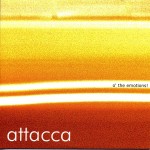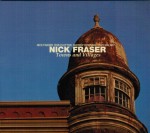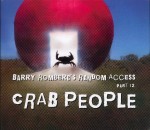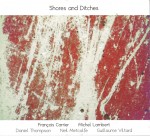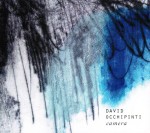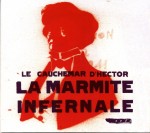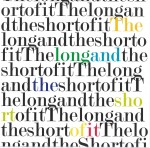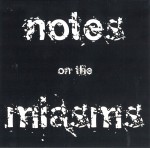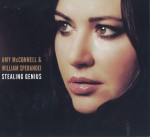Demonstrating that accepted musical customs are often shibboleths — the equivalent of not wearing white after Labour Day — contemporary improvisers frequently express themselves unconventionally — even when it comes to instrumental choices. Take for example the fine duo sessions here. Unaccompanied by others, the players prove that there are enough textures available from nearly identical instruments to create full sound pictures. These sets show not only how much can be done with two guitars — a common combination — but also by two percussion sets, not to mention two saxophones of similar ranges and timbres.
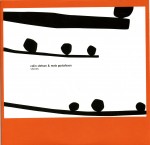 Recorded at the Vancouver International Jazz Festival, Stones (Rue Grammofon RCD 2136 CD runegrammofon.com) matches the tenor and baritone saxophone of Swede Mats Gustafsson with the alto and bass saxophones of Montreal’s Colin Stetson. Although the strength and power available from lower-pitched woodwinds gives the two licence for frequent displays of sternum-shaking and bone-rattling overblowing, the four selections highlight more than just quivering throaty growls. Scattered throughout the dense and nearly opaque duets are mellow connective sequences and some that are created with panache. True, the elegance of tracks such as Stones that Need Not is predicated on acceptance of a climax of slowly melding textures, evolving from one saxman outputting linear tongue smacks and reed sucks, while the other decorates the sequence with chromatic split tones and quivering buzzes. Still, the reed variations are never overly bulky, but instead deconstruct the exposition with crying stutters and emotional in-throat vocalizing. Another strategy, as on Stones that Can Only Be, involves one player concentrating on a pedal-point ostinato with glottal punctuation and finger vibrations, while the second’s altissimo timbres of intense buzzing and slap tonguing decorate the narrative. Such unusual reed techniques may be expected from Gustafsson, whose outstanding free improvisations are on display in many jazz ensembles. However those who only know Stetson from his day job with the pop band Arcade Fire may be shocked and/or impressed.
Recorded at the Vancouver International Jazz Festival, Stones (Rue Grammofon RCD 2136 CD runegrammofon.com) matches the tenor and baritone saxophone of Swede Mats Gustafsson with the alto and bass saxophones of Montreal’s Colin Stetson. Although the strength and power available from lower-pitched woodwinds gives the two licence for frequent displays of sternum-shaking and bone-rattling overblowing, the four selections highlight more than just quivering throaty growls. Scattered throughout the dense and nearly opaque duets are mellow connective sequences and some that are created with panache. True, the elegance of tracks such as Stones that Need Not is predicated on acceptance of a climax of slowly melding textures, evolving from one saxman outputting linear tongue smacks and reed sucks, while the other decorates the sequence with chromatic split tones and quivering buzzes. Still, the reed variations are never overly bulky, but instead deconstruct the exposition with crying stutters and emotional in-throat vocalizing. Another strategy, as on Stones that Can Only Be, involves one player concentrating on a pedal-point ostinato with glottal punctuation and finger vibrations, while the second’s altissimo timbres of intense buzzing and slap tonguing decorate the narrative. Such unusual reed techniques may be expected from Gustafsson, whose outstanding free improvisations are on display in many jazz ensembles. However those who only know Stetson from his day job with the pop band Arcade Fire may be shocked and/or impressed.
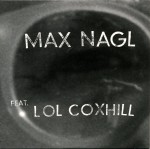 If Gustafsson and Stetson utilize as well as overcome the elephantine qualities of their mammoth saxes, then London’s Lol Coxhill and Vienna’s Max Nagl transcend the perceived delicacy of their soprano saxophones’ timbres. Replacing the other saxophonists’ necessary gravitas with playfulness, the two skip through 16 tracks of solos and duos. Entitled In Memory of Lol Coxhill (Rude Noises 021 www.maxnagl.at), the CD celebrates instances where the experiences of Coxhill (1932-2012) as busker and pop sideman, as well as revered improviser, dovetailed with the skills Nagl, 28 years his junior, had amassed composing theatre and film music. Together the two produce profound improvisations that offer levity without a hint of condescension. Probably the best example of this is Charangalia where the saxophonists’ balanced and affiliated tones circle one another, swaying to a near oomph-pah-pah beat. You can almost imagine the players dressed in matching lederhosen, waltzing around the floor as they flutter-tongue their reeds. On his own, Nagl has a predisposition for calypso themes and breaks up the proceedings with brief asides on harpsichord and guitar; meanwhile Coxhill recounts a shaggy dog story in a plummy accent. Still the sonic fun never takes second place to instrumental excellence. On a track such as zweites Stockwerk, for instance, the two create an entire colour palate from a contrapuntal collection of slide-whistle-like trills, reed-biting squeaks and pronounced slurs plus a mellow, single-note interface. Eventually as the bent note distortions meet, a dual narrative emerges that is both multiphonic and moving.
If Gustafsson and Stetson utilize as well as overcome the elephantine qualities of their mammoth saxes, then London’s Lol Coxhill and Vienna’s Max Nagl transcend the perceived delicacy of their soprano saxophones’ timbres. Replacing the other saxophonists’ necessary gravitas with playfulness, the two skip through 16 tracks of solos and duos. Entitled In Memory of Lol Coxhill (Rude Noises 021 www.maxnagl.at), the CD celebrates instances where the experiences of Coxhill (1932-2012) as busker and pop sideman, as well as revered improviser, dovetailed with the skills Nagl, 28 years his junior, had amassed composing theatre and film music. Together the two produce profound improvisations that offer levity without a hint of condescension. Probably the best example of this is Charangalia where the saxophonists’ balanced and affiliated tones circle one another, swaying to a near oomph-pah-pah beat. You can almost imagine the players dressed in matching lederhosen, waltzing around the floor as they flutter-tongue their reeds. On his own, Nagl has a predisposition for calypso themes and breaks up the proceedings with brief asides on harpsichord and guitar; meanwhile Coxhill recounts a shaggy dog story in a plummy accent. Still the sonic fun never takes second place to instrumental excellence. On a track such as zweites Stockwerk, for instance, the two create an entire colour palate from a contrapuntal collection of slide-whistle-like trills, reed-biting squeaks and pronounced slurs plus a mellow, single-note interface. Eventually as the bent note distortions meet, a dual narrative emerges that is both multiphonic and moving.
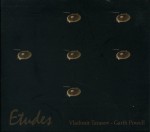 Polyrhythms are the order of the day on Etudes (SoLyd SLR 0414 www.solyd-records.ru), where San Francisco’s Garth Powell and Vilnius resident Vladimir Tarasov share the same extended percussion kit to do a lot more than drum banging. Composers as well as skin beaters, Tarasov and Powell cast these etudes as part faux tutorials and part virtuosic displays. With the American providing brief tongue-in-cheek commentary they proceed to extract beats and vibrations which are often as diaphanous as they are driving. Multiphonic as well as multi-rhythmic, a track like After All suggests the sounds that could arise from a wind machine; while crisp slaps on suspended gongs are matched with friction resulting from violin bows rubbed on cymbals during Strung Up On Your Bow. Picture View Postcards confirms that the correct drum stick sizzle on percussion tops can replicate a dancer’s soft-shoe routine; while the thundering bounces, timely rattles, cascading press rolls and splashing cymbals of No Compensation put aside any doubts as to the drummers’ time-keeping ability, as they swing as effortlessly as Buddy Rich or Max Roach. Despite those skills a track such as My Old Wings is the best example of why they continue to experiment. Spatially organized rather than concentrated, Tarasov and Powell make their triple flams and ratamacues plus mineshaft-deep bass drum reverb reflect the recording space, so that a feeling of powerful motion is present without either having to raise the volume of the performance.
Polyrhythms are the order of the day on Etudes (SoLyd SLR 0414 www.solyd-records.ru), where San Francisco’s Garth Powell and Vilnius resident Vladimir Tarasov share the same extended percussion kit to do a lot more than drum banging. Composers as well as skin beaters, Tarasov and Powell cast these etudes as part faux tutorials and part virtuosic displays. With the American providing brief tongue-in-cheek commentary they proceed to extract beats and vibrations which are often as diaphanous as they are driving. Multiphonic as well as multi-rhythmic, a track like After All suggests the sounds that could arise from a wind machine; while crisp slaps on suspended gongs are matched with friction resulting from violin bows rubbed on cymbals during Strung Up On Your Bow. Picture View Postcards confirms that the correct drum stick sizzle on percussion tops can replicate a dancer’s soft-shoe routine; while the thundering bounces, timely rattles, cascading press rolls and splashing cymbals of No Compensation put aside any doubts as to the drummers’ time-keeping ability, as they swing as effortlessly as Buddy Rich or Max Roach. Despite those skills a track such as My Old Wings is the best example of why they continue to experiment. Spatially organized rather than concentrated, Tarasov and Powell make their triple flams and ratamacues plus mineshaft-deep bass drum reverb reflect the recording space, so that a feeling of powerful motion is present without either having to raise the volume of the performance.
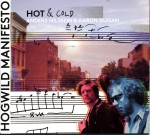 This sort of relaxed intensity also permeates Hogwild Manifesto (Jungulous 003 www.andersnilssonguitar.com), but the jagged electric guitar lines of the duo called Hot and Cold is closer to hearing two Jimi Hendrixes rather than the sedate picking of Chet Atkins and Les Paul or Herb Ellis and Barney Kessel. American Aaron Dugan and Swede Anders Nilsson are sophisticated enough in so-called post-rock and post-jazz styles that they are easily able to work up a track like For Albert which is both thorny and tuneful, wrapping single note finger-picking with arpeggiated climaxes. Elsewhere, one clunks chords and clicks out a slapping ostinato while the other probes the stratosphere with flanged reverb. They subsequently switch roles then cut off the sound in a split second. Like the other duos here they show they’re also capable of subtle swing. For example they approximate an Ellis-Kessel foot-tapping groove on Night Juice Agenda, than quickly splinter it into fuzz-tone reverb and staccato crunches. Tossing ideas back and forth they touch on Middle Eastern-styled licks and highly legato slurred fingering, contrasting buzzing intensity with an overlay of fingerpicking. Before summing up the meeting with exquisite cascades, innate lyricism is on show as much as heavily processed outer space twangs.
This sort of relaxed intensity also permeates Hogwild Manifesto (Jungulous 003 www.andersnilssonguitar.com), but the jagged electric guitar lines of the duo called Hot and Cold is closer to hearing two Jimi Hendrixes rather than the sedate picking of Chet Atkins and Les Paul or Herb Ellis and Barney Kessel. American Aaron Dugan and Swede Anders Nilsson are sophisticated enough in so-called post-rock and post-jazz styles that they are easily able to work up a track like For Albert which is both thorny and tuneful, wrapping single note finger-picking with arpeggiated climaxes. Elsewhere, one clunks chords and clicks out a slapping ostinato while the other probes the stratosphere with flanged reverb. They subsequently switch roles then cut off the sound in a split second. Like the other duos here they show they’re also capable of subtle swing. For example they approximate an Ellis-Kessel foot-tapping groove on Night Juice Agenda, than quickly splinter it into fuzz-tone reverb and staccato crunches. Tossing ideas back and forth they touch on Middle Eastern-styled licks and highly legato slurred fingering, contrasting buzzing intensity with an overlay of fingerpicking. Before summing up the meeting with exquisite cascades, innate lyricism is on show as much as heavily processed outer space twangs.
With the inventiveness implicit in free improvisation, contrasting textures can be sourced from instruments supposedly identical in tones and timbres. These duos confirm the thesis.
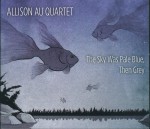 The Sky Was Pale Blue, Then Grey
The Sky Was Pale Blue, Then Grey

